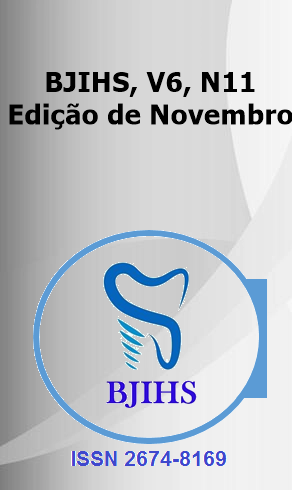Abstract
Warfarin is one of the most widely used oral anticoagulants for the prevention of thromboembolic events in conditions such as atrial fibrillation, venous thromboembolism and prosthetic heart valves. Despite its effectiveness, the main adverse effect associated with its use is the risk of bleeding. This risk is influenced by factors such as the INR (International Normalized Ratio) level, the patient's clinical conditions, concomitant use of drugs that affect coagulation and the duration of treatment. High INR values, particularly above 4, substantially increase the risk of serious bleeding, especially in elderly patients or those with a history of coagulopathies, gastrointestinal bleeding, malignant neoplasms or renal failure. The use of drugs such as nonsteroidal anti-inflammatory drugs, acetylsalicylic acid and others that interfere with platelet function further aggravates the bleeding risk. Discontinuation of warfarin is often considered before surgical interventions to minimize the risk of bleeding. However, this may expose patients to an increased risk of thromboembolic events, since the antithrombotic effect of warfarin takes, on average, four days to wear off and a similar time to recover after restarting treatment. Low-risk bleeding procedures, such as most oral surgeries, have been shown to be safe without stopping the anticoagulant, as long as the INR remains within the therapeutic range. Conversely, in higher-risk situations, such as major ophthalmic surgeries or retrobulbar anesthesia, treatment interruption may be necessary. For patients at high risk of thromboembolism, such as those with mechanical prosthetic valves or hypercoagulable states, bridging therapy with heparin may be indicated. This strategy reduces the time the patient remains without antithrombotic protection and minimizes serious complications. Studies show that thromboembolic complications, including fatal events, are more severe and frequent than hemorrhages in many cases, reinforcing the need for a detailed analysis of the risks and benefits before discontinuing warfarin. In summary, the decision to interrupt, maintain or replace warfarin should be individualized and consider the type of procedure, the hemorrhagic risk and the clinical profile of the patient. Maintenance treatment is generally safe in low-risk surgeries, while more cautious approaches, such as bridging therapy, are reserved for situations of high thromboembolic risk.
References
LEVINE, M. N.; RASKOB, G.; LANDEFELD, S.; KEARON, C. Hemorrhagic complications of anticoagulant treatment. *Chest*, v. 119, p. 108S-121S, 2001.
KEARON, C.; HIRSH, J. Management of anticoagulation before and after elective surgery. *New England Journal of Medicine*, v. 336, p. 1506-1511, 1997.
GARFUNKEL, A.; GALILI, D.; FINDLER, M.; LUBLINER, J.; ELDOR. Bleeding tendency: a practical approach in dentistry. *Compendium*, v. 20, p. 836-852, 1999.
AITHAL, G. P.; DAY, C. P.; KESTEVEN, P. J. L.; DALY, A. K. Association of polymorphisms in the cytochrome P450 CYP2C9 with warfarin dose requirement and risk of bleeding complications. *Lancet*, v. 353, p. 717-719, 1999.
HIRSH, J.; FUSTER, V.; ANSELL, J.; HALPERIN, J. L. American Heart Association/American College of Cardiology Foundation guide to warfarin therapy.Circulation, v. 107, p. 1692-1711, 2003.
WAHL, M. Dental surgery in anticoagulated patients. *Archives of Internal Medicine*, v. 158, p. 1610-1616, 1998.
EVANS, I.; SAYERS, A.; GIBBONS, A.; PRICE, G.; SNOOKS, H.; SUGAR, A. Can warfarin be continued during dental extraction? Results of a randomized controlled trial. *British Journal of Oral and Maxillofacial Surgery*, v. 40, p. 248-252, 2002.
JAFRI, S. M. Periprocedural thromboprophylaxis in patients receiving chronic anticoagulation therapy. *American Heart Journal*, v. 147, p. 3-15, 2004.
SOUTO, J.; OLIVER, A.; ZUAZU-JAUSORO, I.; VIVES, A.; FONTCUBERTA, J. Oral surgery in anticoagulated patients without reducing the dose of oral anticoagulant: a prospective randomized study. *Journal of Oral and Maxillofacial Surgery*, v. 54, p. 27-32, 1996.
LIP, G. Management of anticoagulation before and after elective surgery. *Uptodate*, online 12.2, 2004. Disponível em: <http://www.utdol.com/application/topic.asp?file=coagulat/12261&type=A&selectedTitle=4~174>. Acesso em: 1 out. 2004.
ALEXANDER, R.; FERRETTI, A.; SORENSEN, J. Stop the nonsense, not the anticoagulants: a matter of life and death. *New York State Dental Journal*, v. 68, n. 9, p. 24-26, 2002.
WAHL, M. Myths of dental surgery in patients receiving anticoagulant therapy. *Journal of the American Dental Association*, v. 131, p. 77-81, 2000.
GOHLKE-BÄRWOLF, C.; ZENTRUM, H.; KROZINGEN, B. Anticoagulation in valvar heart disease: new aspects and management during non-cardiac surgery. *Heart*, v. 84, p. 567-572, 2000.

This work is licensed under a Creative Commons Attribution 4.0 International License.
Copyright (c) 2024 Adriano Antunes Miquelante
